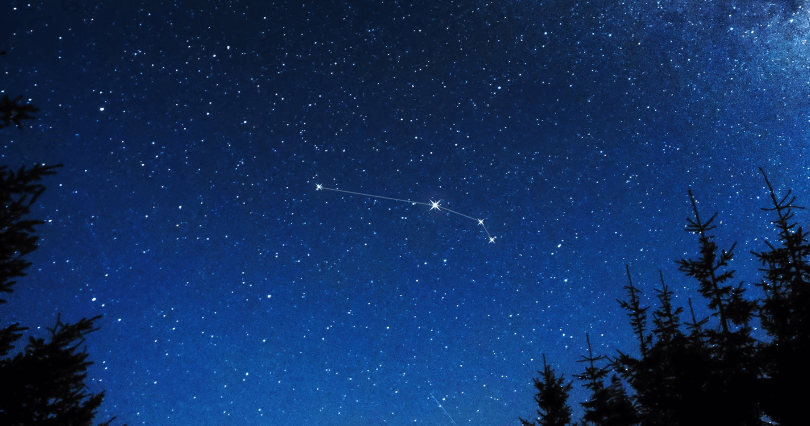
Aries Constellation aka The Ram
We can see the Aries constellation in the northern sky. It is one of the constellations in the Almagest catalogued in the 2nd century by Greek astronomer Claudius Ptolemy. The ancient Greeks related it to the story of the golden ram where the Golden Fleece was from. The Egyptians also have different beliefs regarding the ram constellation. They related it to their god Amon-Ra.
Nowadays, Aries remains a well-known subject in the sky. It is one of the constellations recognized by the International Astronomical Union (IAU). And among the 88 modern constellations, Aries ranks 39th in terms of size. It occupies an area of 441 square degrees or about 1.1% of the sky. We can use the abbreviation “Ari” to refer to this constellation. When talking about its stars, we can use the genitive “Arities.”
Bright stars are not that common in Aries. In fact, it only has two stars brighter than the third magnitude. Celestial objects like interacting galaxies are within the borders of the Ram constellation. Some meteor showers are associated with it.
The Zodiac Family
Aries the Ram is in the zodiac family of constellations. It is represented by the symbol which looks like the male sheep’s horns. The word “zodiac” is from the Latin zōdiacus meaning “circle of animals.” The zodiac constellations are unique in the way they are grouped. They are in the same family because they are positioned in the apparent path of the sun. They are also the basis of the zodiac signs in astrology.
The number of constellations in the zodiac family aligns with the yearly calendar having 12 months. Other members of this family are Taurus (the Bull), Gemini (the Twins), Cancer (the Crab), Leo (the Lion), Virgo (the Virgin), Libra (the Scales), Scorpius (the Scorpion), Sagittarius (the Archer), Capricornus (the Sea Goat), Aquarius (the Water Bearer), and Pisces (the Fishes). The Ophiuchus constellation actually lies in the ecliptic, so some consider it as the 13th zodiac. However, it belongs to the Hercules family.
What’s In A Name?
Aries means “ram” in Latin. Before it became known to many by this name, it was the MULLÚ.ḪUN.GÁ or the Agrarian Worker in Babylonian culture. In later times, it was linked to Dumuzi the Shepherd and the Ram association became more common.
The celestial ram was also important to ancient Egyptians. They called it the “Indicator of the Reborn Sun” because this constellation was the location of the vernal equinox at that time. This location is known as the “First Point of Aries,” where the Sun crosses the imaginary line of the celestial equator. It signals the beginning of the spring season in the Northern Hemisphere.
The equinox is now in Pisces because of the Earth’s precession or slow wobble. The precession is a long cycle that takes 26,000 years to complete. The constellations of the zodiac family will have their turns hosting the vernal equinox during this cycle.
Another title related to Aries was the “Lord of the Head.” And for the Arabic, the ram constellation is called Al Ħamal. It served as the basis of the formal name of its alpha star, Hamal.
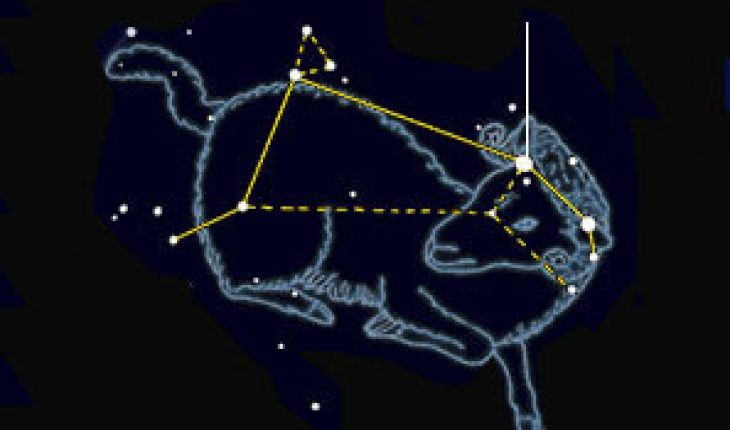
What Does Aries Look Like?
Aries had been interpreted by many cultures throughout the ages so there are many different depictions of how it looks in the night sky. It is more commonly seen as a straight line with a curve.
The curve represents the ram’s head turned backward and the straight line its body. From the left, the stars in the curve are Mesarthim, Sheratan, and its brightest point, Hamal. The relatively bright star in the body of Aries is 41 Arietis.
Like a description of their star positions, Mesarthim and Sheratan were called the “horns of the ram” (qarna al-hamal) by the Bedouin.
Where To See the Aries Constellation
Aries is located in the northern celestial hemisphere. It lies in the first quadrant (NQ1) at 3 hours right ascension and 20 degrees north declination. We can see this somewhat faint constellation if we are between latitudes +90° and -60° here on Earth.
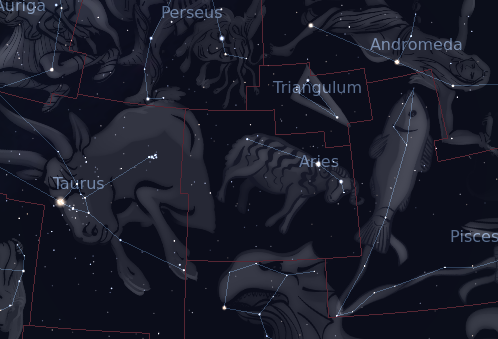
Aries and Its Neighbors
Aries is surrounded by five other constellations. On either side of the celestial ram are other zodiac constellations. These are Taurus (the Bull) to the east and Pisces (the Fishes) to the west. Other neighboring constellations are Perseus (the Hero), Triangulum (the Triangle), and Cetus (the Sea Monster).
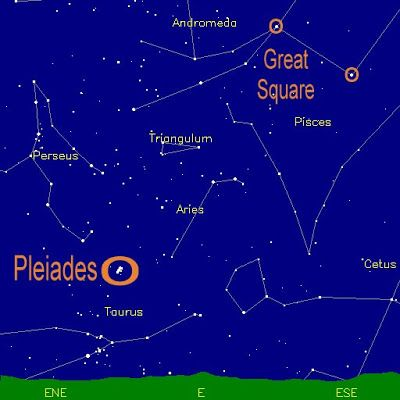
Other Ways to Spot Aries
We can also find Aries by using other features of the night sky as a reference. It is between the Square of Pegasus and the prominent star cluster called the Pleiades. The celestial ram looks as if it is admiring the bright Pleiades because its head is turned towards it!
When To See the Aries Constellation
Aries the Ram is a seasonal constellation that we can see during the autumn months. That means we can spot it in the northern sky from about September to December. The best time for us to see it is during the last month of the year, December, at 9 pm.
Other autumn constellations we can enjoy seeing are Andromeda (the Chained Maiden), Cassiopeia (the Seated Queen), Pegasus (the Winged Horse), Cepheus (the King), Lacerta (the Lizard), and the five constellations bordering Aries.
Aries and Its Stars
Aries is a mid-size constellation but its stars are not exceptionally bright. Only a few of them are visible to the unaided eye. However, its Alpha and Beta stars were used for navigation in the old days.
Single and multiple star systems are within its borders as well as variable ones. The stars R Arietis, U Arietis, and T Arietis are just some examples. There are also stars in the constellation that host exoplanets.
Some of the stars in Aries were given formal names. The International Astronomical Union (IAU) approved six star names in this constellation. These are Hamal, Sheratan, Mesarthim, Botein, Bharani, and Lilii Borea.
Hamal (α Arietis)
Alpha Arietis is the brightest star in the constellation of Aries. It is formally named Hamal and is 13 Arietis in the Flamsteed designation. With an apparent magnitude of about 2.00, it is considered the 50th brightest star that we can see in the sky. It is a suspected variable, with a small amplitude of about 0.6.
Hamal is an evolved giant star in the K-class. It is more massive than the Sun and is more luminous by about 91 times. Its radius is about 15 times that of our Sun’s. It is roughly 66 light-years away from us.
Many consider it as an important star. It was the bright point in the location of the vernal equinox around 2000 and 100 BC. That is the time when people started to explore and know more about the sky. In 2011, a planet was discovered to be orbiting Hamal.
The name Hamal is from rās al-ħamal in Arabic which means “head of the ram.”
Sheratan (β Arietis)
Sheratan is Beta Arietis in the Bayer designation. It marks one of the horns of the celestial ram. It shines with an apparent magnitude of 2.66, making it the second-brightest star in the Aries constellation.
Sheratan is a spectroscopic binary with an orbital period of 107 days. The primary is a fast rotator that is in the main sequence. It has a spectral classification of A5 V. The much fainter secondary is either an F-type or G-type star. This binary star system lies at a distance of about 59.6 light-years.
The name Sheratan is from the Arabic aš-šaraţān, meaning “the two signs.” The other star in this reference is Gamma Arietis. Together, the two stars marked the vernal equinox in the past.
Gamma Arietis (γ Arietis)
Gamma Arietis is a multiple star system. They are designated Gamma Arietis A and Gamma Arietis B. The two have a long orbital period of more than 5,000 years. This system was traditionally called Mesarthim, which is now formally designated to one of its components. It is the fourth-brightest star in the constellation of Aries.
- Gamma Arietis A
Gamma Arietis A is brighter than the other component, having an apparent magnitude of about 4.58. It is a chemically peculiar star that is also variable. It is formally known as Mesarthim.
- Gamma Arietis B
Gamma Arietis B is a fast-spinning main-sequence star. It has a spectral classification of B9 V. Its apparent magnitude is 4.64.
41 Arietis
41 Arietis is one of the main stars in the ram constellation. It is a triple star system of apparent magnitude 3.63, so we can see it in the naked eye. This system is made up of a binary pair and a third companion designated 41 Arietis A and Arietis D.
41 Arietis A is composed of 41 Arietis Aa and 41 Arietis Ab. The primary, 41 Arietis Aa, is formally known as Bharani. The stellar classification of this star is B8 Vn. The name Bharani has its origin in Hindu astronomy.
No Greek letter is assigned in 41 Arietis because it was formerly a part of the constellation Musca Borealis, which is now considered obsolete. The system is 166 light-years away from our Sun.
Botein (δ Arietis)
Botein, or Delta Arietis in the Bayer designation, is a giant star that has undergone stellar evolution. It is a suspected variable with magnitudes changing between 4.33 to 4.37. Its stellar classification is K2 III. It generates energy at the core through helium fusion. This star shines at the brightness of about 45 solar luminosities. It is nearly twice as massive as the Sun.
The name Botein is from the Arabic butain, meaning “belly.” Five stars had the same title Al Buṭain in the constellation before the names were formalized. The star Botein is about 170 light-years away from us.
Epsilon Arietis ( ε Arietis)
Epsilon Arietis is a double star with an overall apparent magnitude of 4.63. The primary and the secondary components are both A-type stars in the main sequence. The apparent magnitude of the primary is 5.2 while the secondary is fainter, having an apparent magnitude of 5.5 The system of Epsilon Arietis is about 330 light-years away.
Zeta Arietis (ζ Arietis)
Zeta Arietis is an A-type star. Specifically, its stellar classification is A1 V. It has an apparent magnitude of about +4.89, so we can see it faintly in the naked eye. This star is about 73 times more luminous than the Sun. It is about 260 light-years distant.
Eta Arietis (η Arietis)
Eta Arietis an F-type star in the constellation of Aries. It has a stellar classification of F5 V. It is 1.3 times as massive as the Sun and has a solar radius of 0.98. This star is about 2.6 billion years old, much younger than our Sun which is 4.6 billion years old. Its apparent magnitude is 5.231.
Eta Arietis is known as 17 Arietis in the Flamsteed designation. It is approximately 94.2 light-years away from us.
Theta Arietis (θ Arietis)
Theta Arietis is a white-hued star in the constellation of the celestial ram. It would look faint to the naked eye as it has an apparent magnitude of 5.58. The stellar classification of this star is A1 Vn. It is 450 light-years distant.
Iota Arietis (ι Arietis)
Iota Arietis is a spectroscopic binary in the Aries constellation. The primary component is a K-type star and the secondary is suspected to be a white dwarf. The pair have an orbital period of 4.3 years.
The apparent visual magnitude of Iota Arietis is 5.117. This system is approximately 520 light-years away from Earth.
Kappa Arietis (κ Arietis)
Kappa Arietis is a spectroscopic star. Both components of this system have the properties of a metallic-lined star and are about the same in terms of brightness. Their orbital period is 15.3 days. The combined apparent magnitude of Kappa Arietis is 5.02. It is located 181 light-years distant from our Sun.
Lambda Arietis (λ Arietis)
Lambda Arietis is a double star. The primary in this system is a white star. It is in the main-sequence, with a stellar classification of F0 V. The secondary has a stellar classification of G1 V. Having an apparent magnitude of 7.75 which is much fainter than the primary which is 4.95.
The Lambda Arietis star system is about 129 light-years away from our planet.
Mu Arietis (μ Arietis)
Mu Arietis is another multiple star system in Aries. Under good sky conditions, it can be visible to the naked eye since its combined apparent magnitude is 5.74. This system has at least four components. It has a close binary with stellar classifications of A0 Vp and F2 V. The third component is an A-type star that orbits the pair. It has an orbital period of 8.845 years. A fourth component was also discovered, having an apparent magnitude of 12.2. The Mu Arietis system is about 340 light-years away from us.
Nu Arietis (ν Arietis)
Nu Arietis is an A-type star in the spectral class A7 V. It has a mass more than twice the mass of the Sun. It radiates with a luminosity of about 63.5 Suns. The apparent magnitude of this star is +5.43. Though it is more massive and more luminous, Nu Arietis is much younger than our Sun. It is only 621 million years old while the Sun is 4.6 billion already. This star is estimated to be about 340 light-years away.
Teegarden’s Star
Teegarden’s Star is one of the closest stars to the Solar System. It is a red dwarf star in the M class. We cannot see it in the naked eye as its apparent magnitude is only 15.1. It is also less massive than the Sun. Compared to other stars, Teegarden’s Star has a large proper motion that is approximately 5 arcseconds every year.
Teegarden’s Star lies at a distance of roughly 12 light-years from our Solar System, which makes it the 24th nearest star. It is named after the American astrophysicist Bonnard J. Teegarden.
Two exoplanets were discovered to orbit around this star. They were designated Teegarden’s Star b and c.
14 Arietis
14 Arietis is a binary star system with an apparent magnitude of 4.98. The primary component belongs to the spectral class F2 III. It is an evolved star that is a rapid rotator. As a result, it has an equatorial bulge. 14 Arietis is about 290 light-years distant.
35 Arietis
35 Arietis is a binary star system with an apparent magnitude of 4.64. The primary star has a spectral classification of B3 V. Its mass is about 5.7 times the mass of our Sun. The orbital period of the components of 35 Arietis is 490.0 days. This system is about 340 light-years away from our planet, Earth.
39 Arietis
39 Arietis is another star in the constellation of Aries that is given an official name. It is formally known as Lilii Borea. The stellar classification of this star is K1.5 III. It is 1.6 times as massive as the Sun and is 56 times more luminous. Lilii Borea has an apparent magnitude of +4.5, so we can see it in the naked eye. It is 172 light-years away from us.
The name Lilii Borea means “in the north of Lilii.” It was from the observation of Nicolas-Louis de Lacaille as he described its position in the now-obsolete constellation of Lilium.
53 Arietis
53 Arietis is a runaway star with an apparent magnitude of 6.10. Its stellar classification is B1.5 V. This star is a Beta Cephei variable and is also known as UW Arietis as its variable star designation. It is estimated to be 800 light-years away from us.
56 Arietis
56 Arietis is another variable star in the ram constellation. It is also known as SX Arietis, its variable star designation. The apparent magnitude of this star ranges from 5.75 to 5.81. The stellar classification of 56 Arietis is B9pSi, which indicates that it is a chemically peculiar star. It serves as a prototype of the SX Arietis variable class. SX Arietis is approximately 406 light-years distant.
Planets in the Ram’s Constellation
At least five stars in the Aries constellation are discovered to host extrasolar planets. Some of them are gas giants while some are super-Earths.
HIP 14810 b
HIP 14810 b is an exoplanet that orbits the star HIP 14810 in the constellation of Aries the Ram. This gas giant has a mass of 3.9 Jupiters. It has an orbital period of 6.7 days. Other exoplanets orbiting the G-type star HIP 14810 are HIP 14810 c and HIP 14810 d. The system lies 165 light-years away from Earth.
HIP 14810 c
HIP 14810 c is another exoplanet in the planetary system of HIP 14810. The mass of this gas giant is equal to 1.31 Jupiters. It was discovered in 2006, one year after the discovery of HIP 14810 b.
HIP 14810 d
HIP 14810 d is the third exoplanet in HIP 14810. This gas giant is less massive than the other two as it has a mass of 0.59 Jupiters. It orbits its star in a period of 2.7 years. It was discovered in 2009.
HD 12661 b
HD 12661 b is an exoplanet that orbits a G-type main-sequence star. This exoplanet is as massive as 2.43 Jupiters. It orbits the star HD 12661 in a period of 262.7 days. The planetary system is 124 light-years distant from us.
HD 12661 c
HD 12661 c is another exoplanet that orbits HD 12661. It is a gas giant that has a mass of 1.812 Jupiters. Its orbital period is 4.7 days. It was detected through radial velocity in 2002.
Teegarden’s Star b
Teegarden’s Star b orbits the red dwarf Teegarden’s Star. This super-Earth has a mass of 1.05 Earths and an orbital period of 4.9 days. It was discovered in 2019. This planetary system is 12 light-years away from us.
Teegarden’s Star c
Teegarden’s Star c is a super-Earth with an orbital period of 11.4 days. The mass of this exoplanet is 1.11 Earths. It was discovered in 2019, the same year of the discovery of Teegarden’s Star b.
Deep-sky Objects in Aries Constellation
No Messier objects were identified in Aries constellation. However, it has several interacting galaxies and other noteworthy celestial objects.
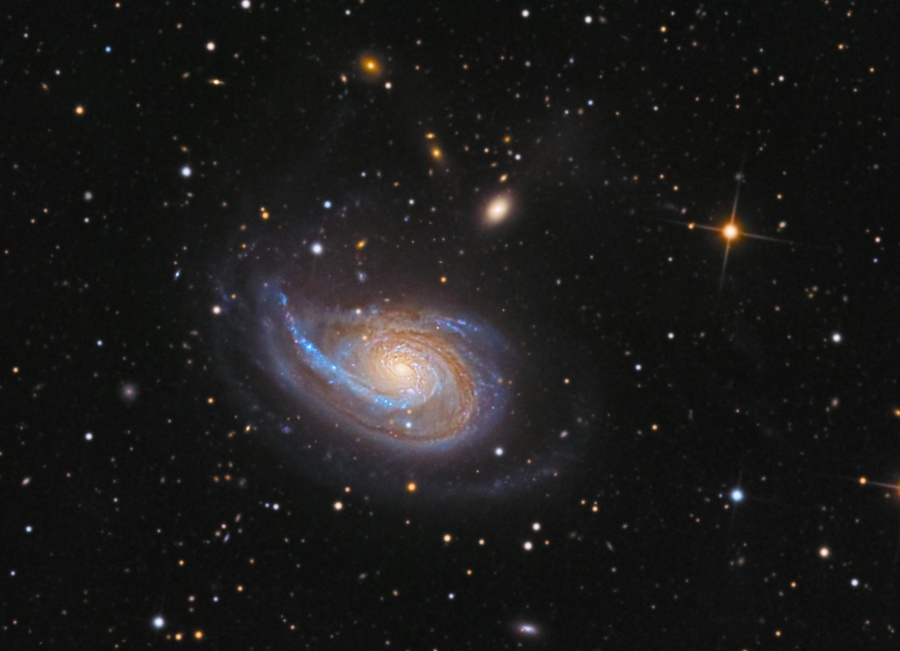
NGC 772
NGC 772 is a peculiar spiral galaxy in the zodiacal constellation of Aries. It is also known as Arp 78. It is more than 100 million light-years away from us. The size of this galaxy is about twice that of the Milky Way’s. There are two supernovae discovered in NGC 772. Moreover, a lot of satellite galaxies surround it including the elliptical galaxy NGC 770, which is gravitationally linked to it.
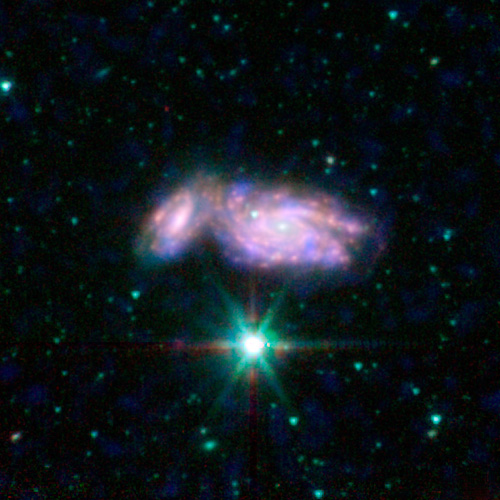
Arp 276
Arp 276 is a pair of interacting galaxies NGC 935 and IC 1801.
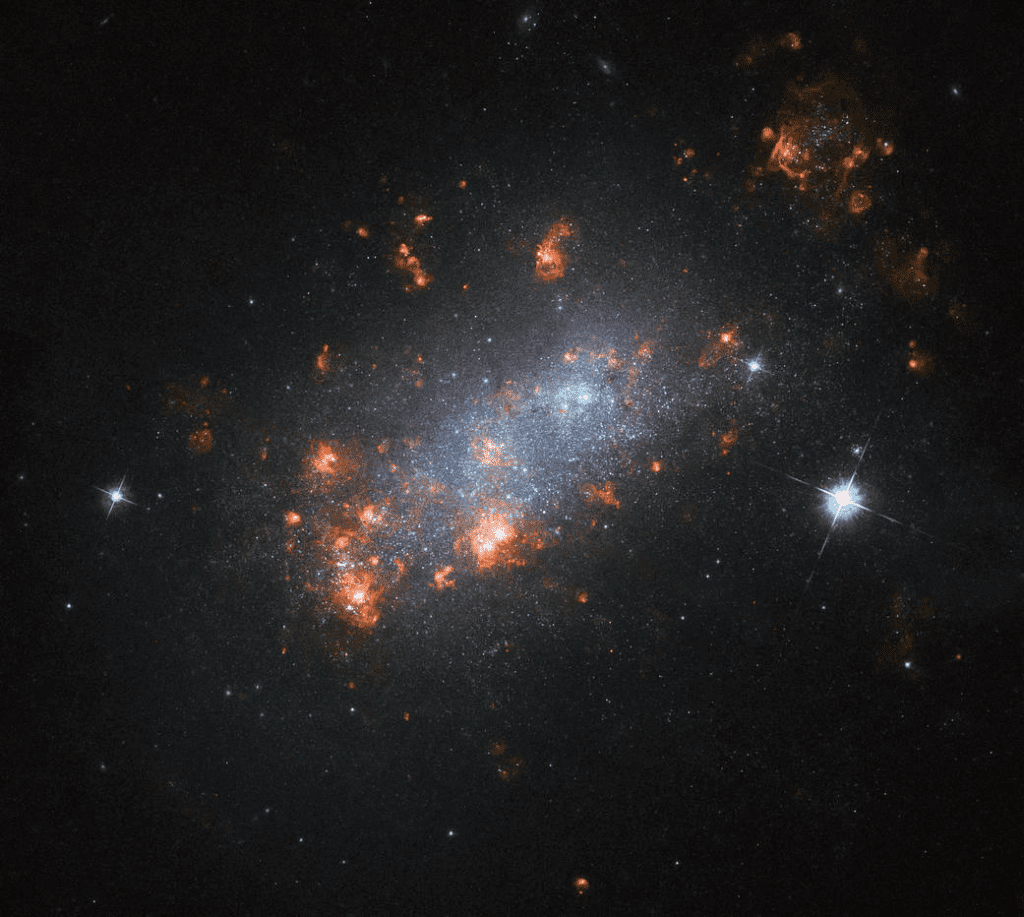
NGC 1156
NGC 1156 is a small irregular galaxy that has a star-packed central region. Many stars are born in its stellar nurseries. This irregular galaxy is considered Magellanic in type. It is thought that NGC 1156 might have had some interaction with another galaxy in the past because of the counter-rotation of gas within the galaxy.
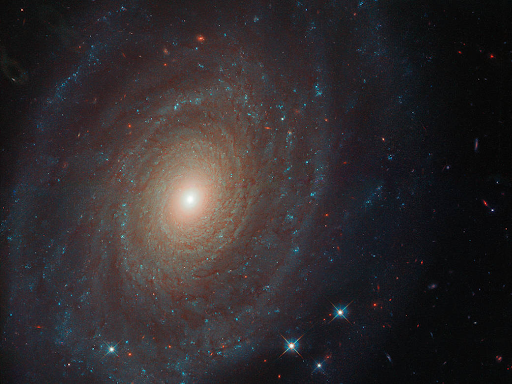
NGC 691
NGC 691 was discovered by William Herschel. It is a spiral galaxy that is roughly 120 million light-years away from our planet. It is 130,000 light-years in diameter. The supernova SN 2005W was discovered in this galaxy. The galaxy group, NGC 691 group, is named after it. Galaxies NGC 680, IC 167, and NGC 694 are members of this group.
Meteor Showers Related to Aries
While there are a number of meteor showers related to other constellations, Aries has six. These are the Daytime-Arietids, Delta Arietids, May Arietids, Autumn Arietids, Epsilon Arietids, and the relatively new discovered shower, Aries-Triangulids.
Daytime-Arietids
The Daytime Arietids, or simply the Arietids, is a daylight meteor shower. It is suspected to be from the asteroid 1566 Icarus. The Arietids are some of the brightest meteors during the day. It occurs yearly from May 22 to July 2, peaking on June 7. During the peak, the shower has a zenithal hourly rate of about 54 meteors. They can be observed just before sunrise. Another daytime meteor shower in the constellation of Aries is the Daytime Epsilon Arietids. The Daytime Arietids were discovered at Jodrell Bank Observatory in 1947.
Delta Arietids
The Delta Arietids radiate from Aries. It lasts from December 8 to January 14, and peaks on December 9. The radiant point of this meteor shower is close to the star HD 59640.
May Arietids
The May Arietids are another meteor shower in the Aries constellation. Its activity period is from May 4 to June 6 and peaks on the 16th of May.
Autumn Arietids
The shower Autumn Arietids is active from September 7 to October 27. It peaks on October 8 where the shower has an hourly rate of about 3 to 5 meteors.
Epsilon Arietids
Epsilon Arietids are another daylight meteor shower in Aries. It lasts from April 25 to May 27, peaking on May 9.

Mythology Related to Aries Constellation
Aries is most commonly related to the golden ram in Greek mythology. The ram was sent to rescue Phrixos and Helle. Let us know more about the story.
King Athamas was the ruler of Boeotia who had many wives. The first one was a cloud nymph named Nephele and the second was Ino, a mortal queen. The king and his first wife had two children, Phrixus (also Phrixos) and Helle.
Ino was a jealous stepmother. She hated them so much that she devised a plan to get rid of them. She brought famine to Boeotia by destroying the crop seeds of the kingdom. Plants could not grow anymore which made the local famine worried. They tried to find a solution to their problem by consulting the Oracle of Delphi. Some men went to consult the oracle but they ended up being bribed by Ino.
Great Sacrifice
When they came back and spread the oracle’s findings to the others, they said that a sacrifice must be made. And this is not just any simple sacrifice, according to them, they need to sacrifice Phrixus to put an end to the famine!
The news reached King Athamas. He felt defeated that he reluctantly agreed to sacrifice his son on Mount Laphystium. But his first wife, Nephele, would not let anything harm her children that he sent a flying golden ram to rescue Phrixus and Helle.
On the way, Helle, unfortunately, fell off the golden ram into the Dardanelles and drowned. Phrixus had to continue on his journey and reached Colchis. Upon arriving, he sacrificed the golden ram to Zeus. Phrixus was greeted and treated well by King Aeëtes so he gave the ram’s golden fleece to the king. Seeing that it is indeed a precious gift, King Aeëtes hung it in a place guarded by a dragon. Phrixus, later on, married Chalciope, the king’s daughter.
The story of the golden ram’s rescue of Phrixos and Helle served as the backdrop of the famous tale of Golden Fleece. This was central in the adventure of Jason and the Argonauts. Interestingly, the strait where Helle drowned was given a name in her honor. It became known as “the Hellespont” which means “Sea of Helle.”
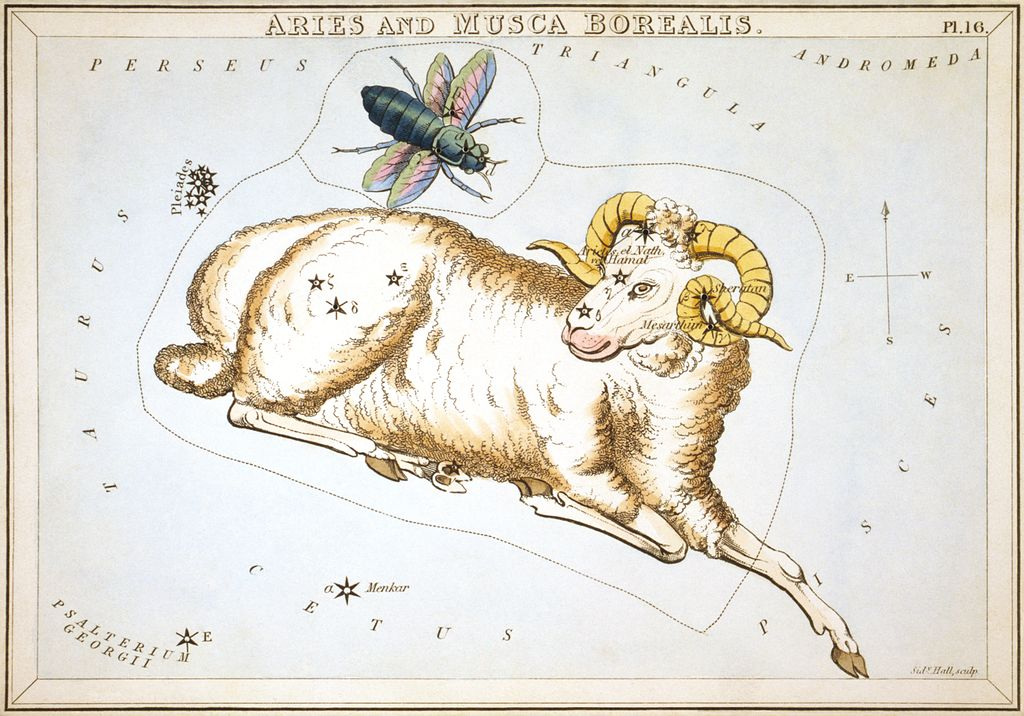
Aries in Urania’s Mirror
Aries was a very close neighbor to the now-obsolete constellation of Musca Borealis. The two were illustrated together in Urania’s Mirror. Musca Borealis means “the northern fly” in Latin. It had undergone many changes in its name. It was created by Petrus Plancius in 1612 and he called it Apes. Jakob Bartsch renamed it in 1624 into Vespa. The same stars in Musca Borealis were later on used by Augustin Royer on his constellation which he named Lilium.
The constellation of Musca Borealis is no longer in use and its stars now belong to Aries the Ram. These stars are 41 Arietis, 39 Arietis, 35 Arietis, and 33 Arietis.